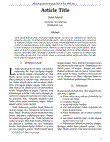Search Results - Zunyi~
Suggested Topics within your search.
Suggested Topics within your search.
- inocuidad 2
- microbiological 2
- Abiotic factors 1
- Agricultural machinery 1
- Antifúngica 1
- Arte feminista latinoamericano 1
- BMI of 22 1
- Basidiomicetes 1
- Basidiomycetes 1
- Beauveria bassiana 1
- Biotic factors 1
- Chicana Feminism 1
- Chicana feminism 1
- Chicano Movement 1
- DPPH 1
- Diversidad fúngica 1
- Drama 1
- Edible coating 1
- Educación continua 1
- Environmental Injustice 1
- Environmental Movements 1
- Enzimas 1
- Epistemic Injustice 1
- Factores abioticos 1
- Factores bioticos 1
- GRAS 1
- Giufà 1
- Historia 1
- IMC de 22 1
- Ideal body weight formulas 1
-
61
-
62
Metal Complexes Containing Natural and Artificial Radioactive Elements and Their Applications
Published 2014“…On the basis of their properties, several mono-, bi-, tri-, tetra- or polydentate ligands have been designed for specific recognition of some particular radionuclides, and can be used in the processes of nuclear waste remediation, i.e., recycling of nuclear fuel and the separation of actinides and fission products from waste solutions or for analytical determination of actinides in solutions; actinide metal complexes are also usefulas catalysts forcoupling gaseous carbon monoxide,as well as antimicrobial and anti-fungi agents due to their biological activity. Radioactive labeling based on the short-lived metastable nuclide technetium-99m (99mTc) for biomedical use as heart, lung, kidney, bone, brain, liver or cancer imaging agents is also discussed. …”
Get full text
Article -
63
The mycetoma knowledge gap: identification of research priorities
Published 2014“…Mycetoma is a tropical disease which is caused by a taxonomically diverse range of actinomycetes (actinomycetoma) and fungi (eumycetoma). The disease was only recently listed by the World Health Organization (WHO) as a neglected tropical disease (NTD). …”
Get full text
Article -
64
The physicochemical, antifungal and antioxidant properties of a mixed polyphenol based bioactive film
Published 2018“…It was possible to determine the MIC50 for the fungi evaluated at concentrations of 558e612 ppm of polyphenols. …”
Get full text
Article -
65
-
66
-
67
Mycelial compatibility, anastomosis, and nucleus numbers of eight Mexican Hirsutella citriformis strains isolated from Diaphorina citri
Published 2021“…Among entomopathogenic fungi, H. citriformis has been recognized as potential biocontrol agent against the Asian citrus psyllid Diaphorina citri (Hemiptera: Liviidae). …”
Get full text
Article -
68
Greener synthesis of chemical compounds and materials
Published 2019“…Non-hazardous solvents including ionic liquids, use of plant extracts, fungi, yeasts, bacteria and viruses are also discussed in relation with materials fabrication. …”
Get full text
Article -
69
Organizaciones No Gubernamentales y Violencia de Género: Caso Nuevo León, México
Published 2021Get full text
Article -
70
Natural inhibitors of pancreatic lipase as new players in obesity treatment
Published 2011“…In a similar way, hundreds of extracts are currently being isolated from plants, fungi, algae, or bacteria and screened for their potential inhibition of pancreatic lipase activity. …”
Get full text
Article -
71
Molecular identification of Fusarium species isolated from transgenic insect-resistant cotton plants in Mexicali valley, Baja California
Published 2015“…Our analyses isolated four native fungi from the rhizosphere of cotton plants, namely, T-ICA01, T-ICA03, T-ICA04, and T-ICA08. …”
Get full text
Article -
72
Diversidad y productividad de macromicetos en tres condiciones de vegetación en el municipio de Pueblo Nuevo, Durango.
Published 2017“…ABSTRACT Each type of vegetation condition has a variety of species of fungi that characterizes it. It is known that there is a close relationship between plant diversity and fungi. …”
Get full text
Tesis -
73
Diversidad y productividad de macromicetos en tres condiciones de vegetación en el municipio de Pueblo Nuevo, Durango.
Published 2017“…ABSTRACT Each type of vegetation condition has a variety of species of fungi that characterizes it. It is known that there is a close relationship between plant diversity and fungi. …”
Get full text
Tesis -
74
Increased Hirsutella citriformis conidia shelf life in Acacia and Hirsutella gum formulations
Published 2023“…Among the biocontrol strategies is the use of entomopathogenic fungi such as Hirsutella citriformis, which has been applied to infect and kill hemipteran insect pests, including Diaphorina citri Kuwayama (Hemiptera: Liviidae) and Bactericera cockerelli Sulc. …”
Get full text
Article -
75
Mycetoma: experience of 482 cases in a single center in Mexico
Published 2014“…It is classified into eumycetoma caused by fungi and actinomycetoma due to filamentous actinomycetes. …”
Get full text
Article -
76
All-around management of a fungal isolate obtained from cheese spoilage as an environmental source: direct approach from an undergrad student to a biotechnological characterization
Published 2019“…Upon conclusion of the research we could recognize that through a direct characterization of a fungal isolate using techniques that are widely known, the student was capable of determining and value one of the most interesting capabilities fungi has to offer; enzymatic activity, and that the knowledge obtained fromestablished protocols enables and encourages the students to correlate the source from where they were obtained with potential biotechnological applications…”
Get full text
Article -
77
Insoluble chitosan complex as a potential adsorbent for aflatoxin B1 in poultry feed
Published 2022“…As a class of secondary metabolites or toxins produced by fungi, aflatoxins can poison humans and animals; among them, aflatoxin B1 (AFB1) is the most dangerous one owing to its carcinogenic and mutagenic properties that increase risks for hepatocellular carcinoma in humans; hence, adsorbents such as smectites are commonly included in poultry feed to mitigate their effects. …”
Get full text
Article -
78
-
79
-
80
Bacillus thuringiensis como agente de control biológico del complejo de la marchitez del chile (Capsicum annuum L.)
Published 2009“…Forty four different localities and several types of pepper were sampled in Durango State, where the presence of several pathogenic fungi to pepper production was observed; being more frequently isolated R. solani, Fusarium spp., Verticillium spp., Colletotrichum spp., Sclerotium spp. and P. capsici. …”
Get full text
Tesis


